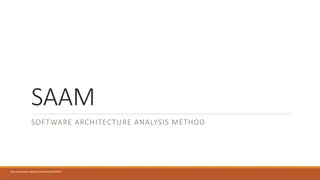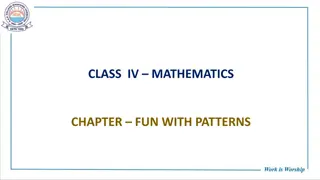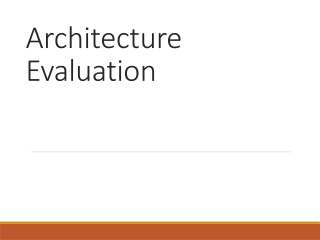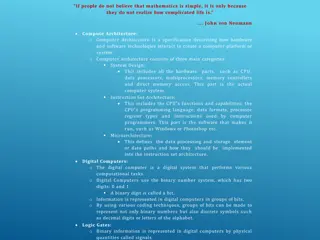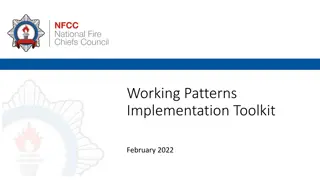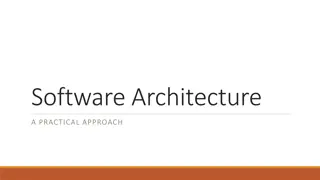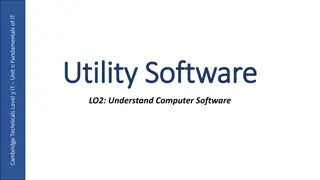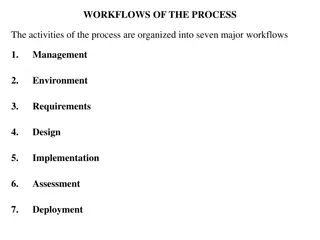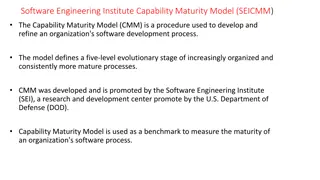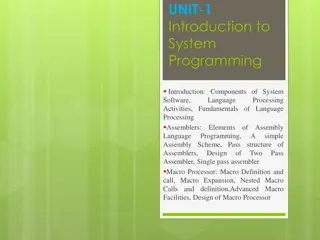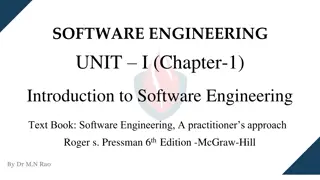Understanding Software Architecture Patterns
Software architecture refers to the high-level structures of a system, including architectural patterns that provide reusable solutions to common problems. Architectural patterns like Layered, Client-server, and Master-slave help in breaking down large systems for better management and maintenance. Layered pattern, also known as n-tier architecture, organizes programs into layers like Presentation, Application, Business Logic, and Data Access. It involves defining stable interfaces between layers and building components within each layer at the same level of abstraction. Error handling is done at the lowest level possible.
Download Presentation

Please find below an Image/Link to download the presentation.
The content on the website is provided AS IS for your information and personal use only. It may not be sold, licensed, or shared on other websites without obtaining consent from the author. Download presentation by click this link. If you encounter any issues during the download, it is possible that the publisher has removed the file from their server.
E N D
Presentation Transcript
Software Architecture Software architecture refers to the high level structures of a software system, the discipline of creating such structures, and the documentation of these structures. These structures are needed to reason about the software system. An architectural pattern is a general, reusable solution to a commonly occurring problem in software architecture within a given context. Architectural patterns are similar to software design pattern but have a broader scope. Wikipedia 2
Architectural Patterns Architectural Patterns The fundamental problem to be solved with a large system is how to break it into chunks manageable for human programmers to understand, implement, and maintain. Large-scale patterns for this purpose are called architectural patterns.
Architecture Patterns 1. Layered pattern 2. Client-server pattern 3. Master-slave pattern 4. Pipe-filter pattern 5. Broker pattern 6. Peer-to-peer pattern 7. Event-bus pattern 8. Model-view-controller pattern 9. Blackboard pattern 10. Interpreter pattern
1. Layered 1. Layered pattern pattern This pattern is also known as n-tier architecture pattern. It can be used to structure programs that can be decomposed into groups of subtasks, each of which is at a particular level of abstraction. Each layer provides services to the next higher layer. Usage General desktop applications. E commerce web applications.
Common layers of a general information system Presentation layer (also known as UI layer) Application layer (also known as service layer) Business logic layer (also known as domain layer) Data access layer (also known as persistence layer)
Layered pattern Different levels of abstraction Requests go down, notifictions go back up Possible to define stable interaces between layers May add or change layers over time
Layered pattern Solution Start with the lowest later Build layers on top Use same level of abstraction within each layer Componenets cannot spread over two layers Keey lower layers lean Specify interfaces for each layer Handle errors at the lowest level possible
2. Client 2. Client- -server pattern server pattern This pattern consists of two parties; a server and multiple clients. The server component will provide services to multiple client components. Clients request services from the server and the server provides relevant services to those clients. The server continues to listen to client requests. Usage Online applications such as email, document sharing and banking.
3 3. . Master Master- -slave pattern slave pattern This pattern consists of two parties; master and slaves. The master component distributes the work among identical slave components, and computes a final result from the results which the slaves return. Usage In database replication, the master database is regarded as the authoritative source, and the slave databases are synchronized to it. Peripherals connected to a bus in a computer system (master and slave drives).
4. Pipe 4. Pipe- -filter pattern filter pattern This pattern can be used to structure systems which produce and process a stream of data. Each processing step is enclosed within a filter component. Data to be processed is passed through pipes. These pipes can be used for buffering or for synchronization purposes. Usage Compilers. The consecutive filters perform lexical analysis, parsing, semantic analysis, and code generation. Workflows in bioinformatics.
Pipes eliminate need for intermediate files Can replace filters easily Can achive different effects through recombination f data stream format is standard, filters ay bbe developed independently Parallelization possible
Data Stream processing may be subdivided into stages May recombine stages Non adjacent stages do not share information May desire different stages to be on different processors Standardized data structure between stages
5. Broker 5. Broker pattern pattern This pattern is used to structure distributed systems with decoupled components. These components can interact with each other by remote service invocations. A broker component is responsible for the coordination of communication among components. Servers publish their capabilities (services and characteristics) to a broker. Clients request a service from the broker, and the broker then redirects the client to a suitable service from its registry. Usage Message broker software such as Apache ActiveMQ, Apache Kafka, RabbitMQ and JBoss Messaging.
6. Peer 6. Peer- -to to- -peer pattern peer pattern In this pattern, individual components are known as peers. Peers may function both as a client, requesting services from other peers, and as a server, providing services to other peers. A peer may act as a client or as a server or as both, and it can change its role dynamically with time. Usage File-sharing networks such as Gnutella and G2) Multimedia protocols such as P2PTV and PDTP. Proprietary multimedia applications such as Spotify.
7. Event 7. Event- -bus pattern bus pattern This pattern primarily deals with events and has 4 major components; event source, event listener, channel and event bus. Sources publish messages to particular channels on an event bus. Listeners subscribe to particular channels. Listeners are notified of messages that are published to a channel to which they have subscribed before. Usage Android development Notification services
8. Model 8. Model- -view This pattern, also known as MVC pattern, divides an interactive application in to 3 parts as, model contains the core functionality and data view displays the information to the user (more than one view may be defined) controller handles the input from the user This is done to separate internal representations of information from the ways information is presented to, and accepted from, the user. It decouples components and allows efficient code reuse. view- -controller pattern controller pattern Usage Architecture for World Wide Web applications in major programming languages. Web frameworks such as Django and Rails.
9. Blackboard pattern 9. Blackboard pattern This pattern is useful for problems for which no deterministic solution strategies are known. The blackboard pattern consists of 3 main components. blackboard a structured global memory containing objects from the solution space knowledge source specialized modules with their own representation control component selects, configures and executes modules. All the components have access to the blackboard. Components may produce new data objects that are added to the blackboard. Components look for particular kinds of data on the blackboard, and may find these by pattern matching with the existing knowledge source. Usage Speech recognition Vehicle identification and tracking Protein structure identification Sonar signals interpretation.
Problem solvers work independently on part of the problem Share common data structure Central controller manages access to the blackboard Blackboard may be strcured in levels of abtraction to allow work at different levels Blackbpard contain original input and partial solutions
Difficult to test Difficult to guarantee an optimal solution Control strategy often heuristic May be computationally expensive Parallelism possible
10. Interpreter pattern 10. Interpreter pattern This pattern is used for designing a component that interprets programs written in a dedicated language. It mainly specifies how to evaluate lines of programs, known as sentences or expressions written in a particular language. The basic idea is to have a class for each symbol of the language. Usage Database query languages such as SQL. Languages used to describe communication protocols.
https://towardsdatascience.com/10-common-software-architectural- patterns-in-a-nutshell-a0b47a1e9013









